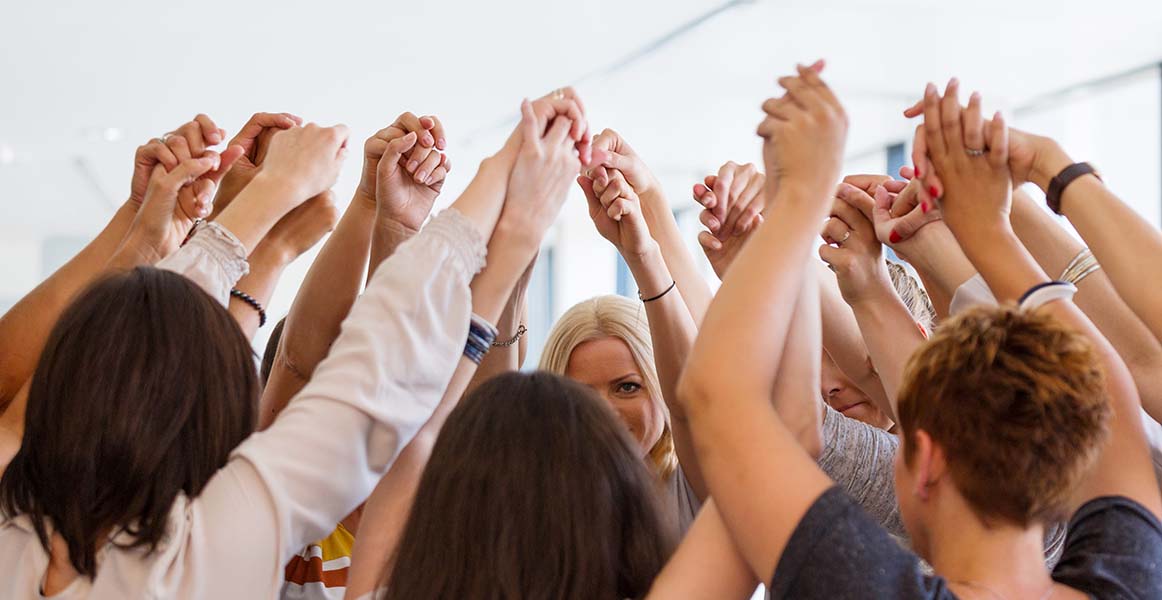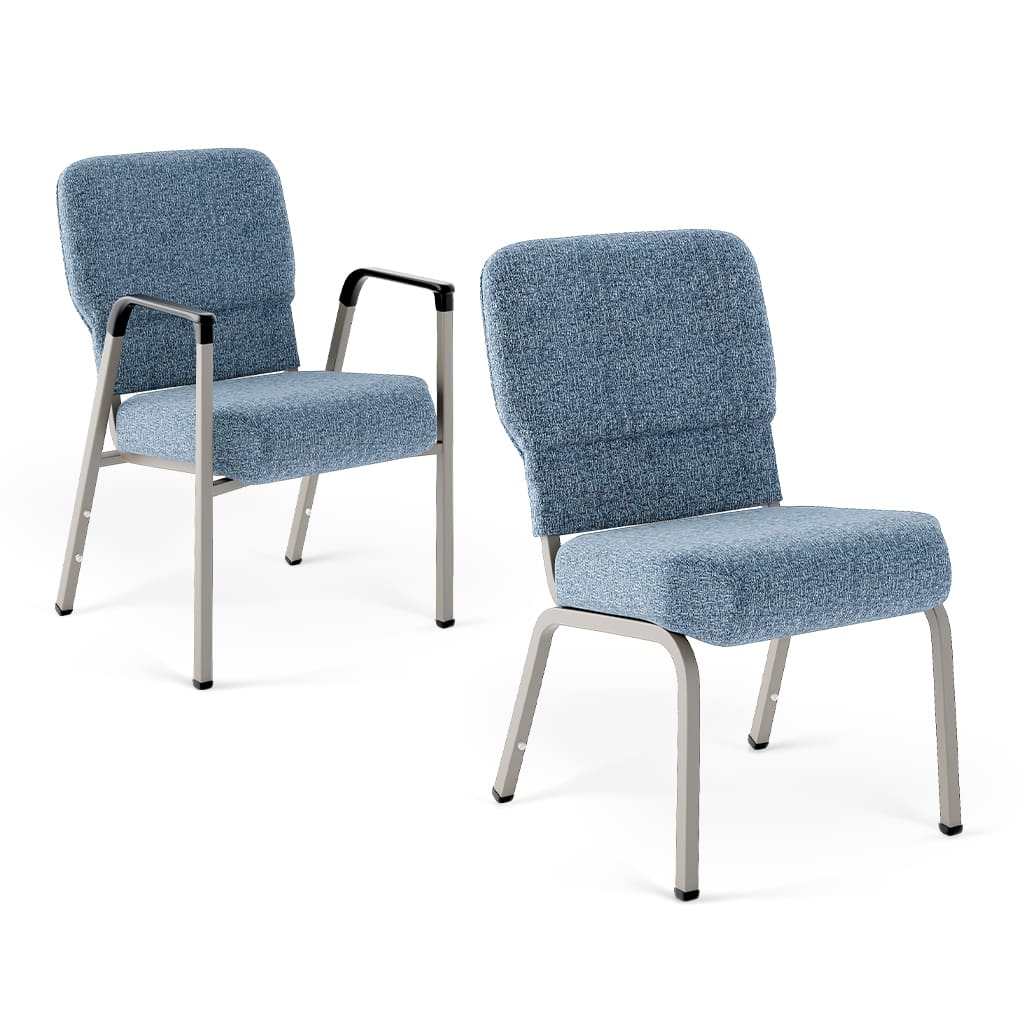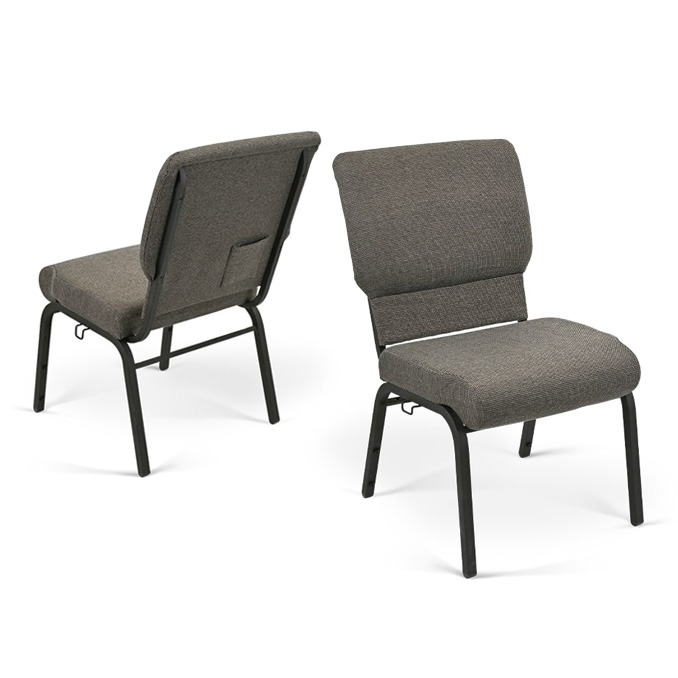For more than 70 years, Bertolini has partnered with churches, community centers, and faith-based groups to help outfit their buildings with the best chairs. We know that for many churches that are high on faith and low on budget, big purchases like furniture can be easy to put off. However, many churches have found that providing church members with comfortable and updated seating is an investment that pays off in increased attendance, engagement, donations, and membership.
We think your members deserve the best chairs on the market—chairs that will look beautiful in your space and last for many years to come. If you don’t have enough cash in the budget to purchase the chairs you want, you can raise the necessary money through fundraising.
Fundraising is one of the most important yet challenging aspects of church leadership. That’s why we’ve put together an ultimate fundraising guide to assist you. These tips can help you get started.
Section 1: What to Look for in Church Chairs

How do you know you’re purchasing the best chairs for your money?
You might have noticed that church chairs come in all price ranges, from cheap imports that will only last a few years to exquisitely carved hardwood chairs that look fit for a king.
If you’re skipping the fancy carved chairs with velvet fabrics, you’ll find that most standard upholstered church chairs look about the same on the outside. They will have a metal frame and an upholstered seat and back, which may be available in different fabrics. This visual similarity can make it difficult to compare quality and select from various chairs to ensure you’re getting the most for your money. When gauging the quality of church chairs, it’s what’s inside the chair that matters, and that’s what sets apart the good chairs from the bad.
After reading this section, you will know exactly what questions to ask and what to look for when purchasing your chairs. If you’re careful about your purchase, you can get new chairs that are reasonably priced and will last for a decade or longer.
After reading this section, you will know exactly what questions to ask and what to look for when purchasing your chairs.
How to choose the right chair frame
The main types of chair frames for church chairs are metal and wood. Steel chair frames are among the most durable types of chair frames and require the least amount of maintenance. They are also less expensive than wood chair frames and they can be easily customized by the manufacturer to add bookracks, cup holders, and other accessories for the comfort and convenience of your congregation.
In most cases, we recommend that churches purchase the most durable (and economical) chairs: church chairs with steel or aluminum frames. Wood can be difficult to care for in humid or cold climates, and it is less stackable. Wood chairs will also not support the weight of some individuals.
Look for a steel frame that is powder-coated to ensure the paint won’t chip or rub off. You may also want to look for frames that include a stack bar to minimize damage to cushions over time.
Why seat and back support matters
It’s important to know what’s under the fabric and foam of a chair. The most common seat bases and back support bases are made from wood or molded plastic. Chairs with wood seat bases and back support pieces are the most inexpensive; however, they are also the most uncomfortable and the heaviest to lift. Plastic seats and backs are more expensive, but they have many benefits.
Plastic seats are more comfortable, and they allow for greater airflow (helping your congregation not feel hot or stuffy). Slightly flexible, a plastic seat base is as durable as wood and it has the same stacking capacity, but it’s lighter, easier to repair (with no screws to fall out), and makes for a much more comfortable seating experience.
Plastic seat and back bases are more expensive than bases made of compressed wood, but they have many benefits. Plastic seat bases are extremely durable. They can be molded to the shape of the body, making them more comfortable. Chairs made with plastic bases have the same stacking capacity, but they’re lighter, easier to repair (with no screws to fall out), and more breathable.
What you should know about foam
The type of foam you choose really matters because low-quality foam won’t last, causing the comfort level of the chair to quickly decline. Cheap foam can break down prematurely, causing clumps or compressing into a flat, uncomfortable mat.
You’ll get more consistent seat comfort and greater overall comfort if you purchase chairs with high-quality foam. Even better, you can choose a manufacturer that produces its own foam cushion, so you will get higher-quality foam for a lower cost (since there will be no middleman).
The highest quality foam we have found is cold-cured, high-resilience, flex-molded foam. This is the foam we use in our Impressions Chair.
We manufacture our foam cushions in-house, enabling us to offer higher-quality foam at a lower price than you can find elsewhere. The Impressions Chair comes with a 25-year warranty on both the foam and the frame.
Open-cell or TDI foam is cheaper, but it breaks down more quickly and is less comfortable.
Why footprint is important
When you’re comparing stacking church chairs, make sure you ask about the footprint of stacking chairs for storage purposes. The footprint of a stack of chairs is the amount of space it takes up. Some chairs can stack 4 high, while others stack 8 high. The higher the number of chairs in a stack, the less storage you will need.
You should look for chairs that stack 8 high, and choose chairs that are designed to stack vertically. Before making a purchase, ask how many square feet one stack of chairs will occupy. Also, ask how far the stack will creep out from the wall.
This rendering demonstrates what we mean when we talk about a stacking chair’s footprint. Although stacking chairs may seem comparable, once stacked, some can have a much larger footprint than another chair, which means it will take up more storage space.
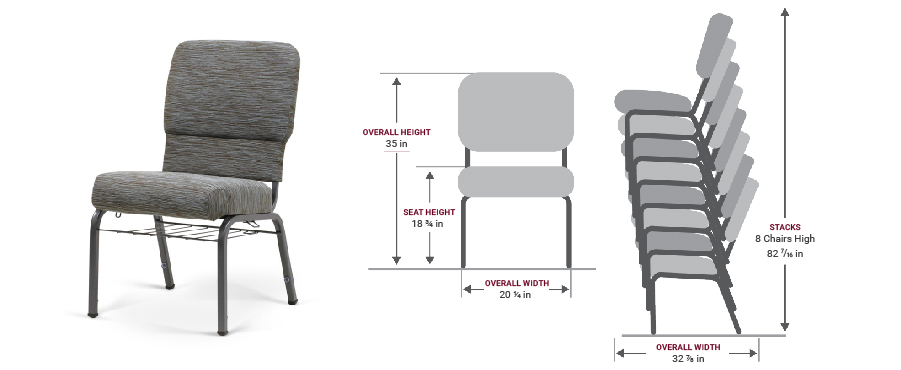
Why do we think Bertolini chairs are the best? We’re glad you asked!
Bertolini Impressions Church Chairs are manufactured in the USA using the highest quality, cold-cured foam. We pour and cure the foam in-house at our manufacturing facility in Utah, which gives us 100% control on the quality. That’s why Bertolini Impressions Chairs are the most comfortable, and longest-lasting chairs you can buy.
Bertolini’s Plush Foam Seats
If a foam seat is too soft, a person will sink through the foam after sitting for a long period of time. The seat will suddenly feel hard and uncomfortable because you’re sitting on the seat bottom. This is called bottoming out. However, if the foam is too stiff, it will feel uncomfortable immediately and can cause backaches or other discomfort.
Therefore, you want a foam seat cushion that is neither too soft nor too stiff.
The Bertolini Impressions Chair features a custom-made, cold-cured, flex-molded foam seat cushion. It has medium to high load-bearing properties, so that it feels soft while being firm enough to avoid bottoming out. This makes sitting in a Bertolini church chair comfortable for any period of time.
Section 2: Where to Start

5 Tips That Will Help
When it comes to fundraising, it’s a common misstep for organizations to simply jump into planning an event without first determining what type of fundraiser would best fit their needs, or whether they even need to host a fundraiser at all.
Before wasting valuable time and resources planning a large event, take the time to discuss your goals to ensure you’re heading in the right direction. Start by asking these five questions.
1. How much do you need to raise?
Once you determine the chairs you want, you’ll need to estimate the number of chairs you need to order. Will you only be purchasing chairs for the worship area, or do you also need chairs for other rooms throughout the facility? If you have a rough idea of square footage and how the chairs will be used, a good sales representative should be able to help you estimate the order quantity.
Once you have this information, you’ll know your required budget and you can use that to determine how much additional money you need.
2. What type of fundraiser should you do?
There are many ways to fundraise successfully. The question of which fundraiser is the best for your church will depend on many factors, including the time and talents of the fundraising committee and the needs of your church. Sometimes, it’s simply a matter of calling for donations during a church service, while at other times, a large event may be the best approach.
Find fundraising ideas in Section 4.
3. Who should be involved?
If you are hosting an event, it’s essential to have your team in place before you start planning. Start by choosing a leader or committee chair. Finding the right people to plan the event is central to success.
How do you find the right group? Discover traits to look for in Section 5.
4. How should you start planning?
Take the time to plan before selecting a date and announcing the fundraiser. This may sound obvious, but you’d be surprised how many churches simply announce that they are having a fundraiser before the details are in place. It’s essential to determine how much you need to raise and identify the type of fundraiser that would be most suitable.
5. What’s the most important part of fundraising?
The Golden Rule of fundraising is, don’t be afraid to ask! That sounds simple, but it can be surprisingly difficult for some people. The reason it’s the Golden Rule is that the number one reason people don’t donate to a certain church is not that they cannot afford to donate, but because no one asks them to donate in the first place. Once you ask, you’ll likely be surprised by the generosity of the people you know.
Sometimes a Flyer Is All You Need
Perhaps after reading this E-Book, you will decide you’re not ready to launch a full-scale fundraising event. However, you might still need money for something like new chairs to outfit your church. That’s okay. Simple is sometimes better.
You’ll find a sample fundraising flyer in Section 8. You can use this as a template to create your own flyer or print the page and make copies to pass out during Sunday services. Alternatively, many churches find success with an online fundraising campaign (such as GoFundMe) to raise money for new church chairs.
Section 3: Know Your “Fundraising Why”

Do you know why you’re holding a fundraiser?
The most successful fundraisers have a specific goal or vision in mind. Simply needing more money to grow your church is not specific enough. For example, if you need to raise money in order toto purchase It’s important to have one specific goal for any fundraiser, rather than a general goal. The most successful fundraisers have a specific goal or vision in mind. Simply needing more money to grow your church is not specific enough. For example, if you need to raise money to purchase new chairs for your church, communicate that clearly.
It can be helpful to tell people how the fundraiser will benefit them. How will purchasing new chairs benefit them? You could talk about the comfort or the fresh, new appearance.
Having a clear goal in mind also requires that churches shouldn’t fundraise unless it’s needed. People don’t like being bombarded with fundraisers, so avoid having one if there are funds elsewhere that could cover the cost of the new chairs.
Once you have your fundraising “why,” the other aspects of fundraising will likely fall into place. Churches fundraise for various reasons, in addition to purchasing new furniture and supporting their infrastructure. Here are just a few.
Common Causes for Church Fundraisers
Education:
- Church camp
- Bible school
- Sunday school
- Women’s groups
- Youth groups
- Children’s groups
- School uniforms
- Youth/adult conferences
Community Outreach:
- Missionary work
- Food pantries
- Ladies’ aid societies
- Homeless shelters
- Relay for Life and other health-related charities
Membership Services:
- Member healthcare aid fund
- J.O.Y. circles
- Sunday school supplies
- New building, expansion, or remodeling
- New church pews or chairs
- Ushers
Section 4: Different Ways to Fundraise

What type of fundraiser fits?
The best type of fundraiser for your church will depend in part on how much you need to raise.
Because churches are community-based organizations, they’re in a unique position. There’s great potential for successful fundraising if you have a specific goal and can determine what type of fundraiser will help you achieve that goal.
Although many people associate the term “fundraising” with large events or bake sales, there are numerous other ways to raise money. Here are a few different types of fundraisers that might work for you and your church.
The $500 Dollar Wheelbarrow
A large wheelbarrow can hold at least 50,000 pennies, which equals $500. Put a wheelbarrow in your worship center and invite members to donate pennies.
Cupcake Bar
Have volunteers bake an assortment of unfrosted cupcakes that you can sell and then invite people to decorate them as a fun activity. This is a great type of event to hold after a service. You can also sell coffee, tea, sodas, and other drinks.
World Food Day
Invite members from a variety of cultures to make a traditional cuisine for the congregation to sample, then charge for event tickets or by plates of food.
Crowdfunding Campaign
A crowdfunding fundraising campaign is an effective way to raise money by collecting small donations from a large number of people, typically online. You can use a free crowdfunding platform like GoFundMe, GiveSendGo, or Fundly to run the fundraiser.
Play or Talent Competition
Sell tickets to a show performed by your congregation’s youth group or children’s classes. People love to see kids perform!
Childcare Services
Offering childcare with the help of volunteers can provide a great service for couples in need of a date night. It can also provide an ongoing resource for profit. Check state licensing requirements if you opt to create a long-term church daycare service as a source of funding.
Cakewalk
Charge a participation fee for members to participate in a cakewalk, where volunteers walk around and taste each cake, then vote for a winner.
Gingerbread House Auction
Have volunteers spend an evening making gingerbread houses to be auctioned off after the next service.
Holiday Gift -Wrapping
Charge a small fee for volunteers to wrap presents for people in the congregation during the holiday season.
Quiz Night
Charge admission and pick a theme, such as a holiday or a “get-to-know-your-Bible-stories” event. The winners may receive a prize.
Car Wash
Gather volunteers and supplies and charge a small fee for the congregation and community members to get their cars cleaned.
Bazaar
Assemble a group of volunteers and host your own bazaar or market to sell a variety of items. Charge each booth a fee or have them donate a percentage of their profit to the church.
Member Auction
Host an auction where volunteers from your church can showcase their skills and talents to others. You can auction off things like a home-cooked meal, a family photo session, yard work, and knitting. Get creative!
Flower Sale
Sell flowers during special holidays like Christmas, Valentine’s Day, Easter, Mother’s Day, etc.
5K Run/Walk
Host a 5K for the runners/walkers in the congregation with a set fee for each runner and the ability to gather donations to support teams and individual participants.
Golf Tournament
Contact a local county club or golf course to see if you can arrange a fun tournament where a portion of the entry fee is donated to your church.
Silent Auction
A silent auction can help augment ticket sales for an event or be part of a simple event, such as an after-service luncheon.
Raffle
Gather in-kind donations and determine the price for each ticket by calculating the amount needed to raise; then, divide that amount by the number of items donated. Check state laws regarding raffles to make sure you won’t be charged any taxes or fees. A raffle may not be a good idea for your congregation if the tax expense would cancel out any profit from the raffle.
Ticketed Dinner
Have a themed fundraiser dinner and sell tickets for entry. You can determine the ticket price by adding the cost of the food to the fundraiser goal amount.
For a church raising money for new chairs, a crowdfunding campaign works like this:
- Set a goal – Determine how much money is needed to buy the chairs.
- Choose a platform – Use a site like GoFundMe, GiveSendGo, or another church-friendly fundraising platform.
- Tell your story – Create a campaign page that explains why new chairs are needed, how they will benefit the church, and how much each chair costs.
- Promote the campaign – Share it with the congregation, local community, and on social media. Encourage members to spread the word.
- Receive donations – People contribute any amount they can, and some might even sponsor a full chair.
- Thank supporters – Keep donors updated and express gratitude. You can also tag chairs with donor names or host a dedication service as a gesture of thanks.
Section 5: Find Your Fundraising Team

Choose Your Team
The key to fundraising successfully is having a great team and a strong leader.
Enlisting a dedicated group of people is the best way to ensure fundraising success; however, it’s essential to have a great leader in place to keep the project on track. This requires having a leader with the necessary skillset and availability, as well as a commitment to completing the task.
Is there someone in your congregation who consistently takes the lead and is seeking opportunities to become more involved? That person could be the leader you need!
Here are some of the traits you can look for when searching for your fundraising team leader. Most leaders won’t have all of these traits; different traits will give your leader different strengths.
- Empathetic and kind to others
- Organized and good at planning
- Steps up to help without being asked
- Honest and dependable
- Communicates effectively
- Comfortable using social media
- Social and friendly (a “people person”)
- Flexible and easy to work with
- Avoids drama and gossip
- Motivates others to take action
- Available and not overcommitted or overwhelmed in other aspects of life
What’s the #1 trait to look for? (Remember the golden rule!)
Make sure your fundraising leader is the type of person who is not afraid to ask for what they need.
People who might make great team members
Once you have your team leader, that person can help you put a committee in place. Look for people who have similar traits to your leader. Also, look for people with the specific experience and skill set you need to help make your event successful. For example, if you are collecting donations through a GoFundMe campaign, look for people who are active on social media or who are good at writing.
Potential Committee Members
Once your fundraiser leader and your committee members are in place, it’s time to figure out who else in your congregation should be involved. For example, if you are raising money for a youth group bible camp, consider having members of the youth group actively participate. When people communicate directly with the people who will benefit from the fundraiser, they will be more likely to donate. For a fundraiser for new church chairs, consider having the ushers, the greeting committee, or other interested groups participate.
Section 6: Fundraisers with Strong ROI

Follow these 5 Steps to Achieve Your Fundraising Goals
A fundraising event must be profitable — otherwise, you’re wasting your time and the time of all those involved. So, how do you host an event with a strong return on investment?
Follow these steps before planning your event to ensure your final profits outweigh your initial investment. This works for any type of fundraiser, from a simple bake sale to a large-scale gala.
Step 1: Confirm 501(c)(3) Status
If your church is a registered 501(c)(3) nonprofit organization, you should be charged the wholesale price by each vendor, and you are exempt from paying tax. If you’re not registered yet, pause the fundraising process until that’s in place.
Step 2: Create a Budget
List out every item you will need, along with the estimated cost. Remember the little things like printing event tickets and offering bottled water for volunteers. Tally the estimated total cost.
Step 3: Purchase Goods & Services
It’s time to approach vendors! As a 501(c)(3), you should be charged the wholesale price for everything, and you should not be charged tax. And remember the golden rule! Ask the vendor to donate a percentage or invite them to be a sponsor.
Step 4: Determine the Amount to Raise
Figure out how much money you need to raise in order to meet your goal once you subtract the estimated cost for products and services.
Step 5: Establish Cost of Admission
Knowing how much you need to raise to reach your goal will help you determine the appropriate admission or event ticket price. Estimate how many people you think will attend and multiply that by the cost per ticket.
Step 6: Identify Additional Revenue Options
It’s likely you won’t be able to raise the total amount needed through ticket sales alone. If the cost of entry is too high, it might limit attendance. Look for other ways to generate revenue, such as a raffle, silent auction, live auction, or a cash bar, among other options that work well for your members.
Section 7: Calculate Your Needs

How much money does your event need to raise?
Use this formula to determine attendance goals, ticket prices, and more. Using these calculations will help you determine if your fundraising strategy is likely to be successful. You might need to return to the drawing board, but it’s better to do that before you start investing time and money in an event that won’t achieve your goals.
Does the ticket price seem too high?
Once you know how much you need to raise outside of ticket sales, you can begin pricing other items, such as drinks, and figure out how many donations you need to gather for raffles, auctions, etc.
Section 8: Fundraiser Flyer
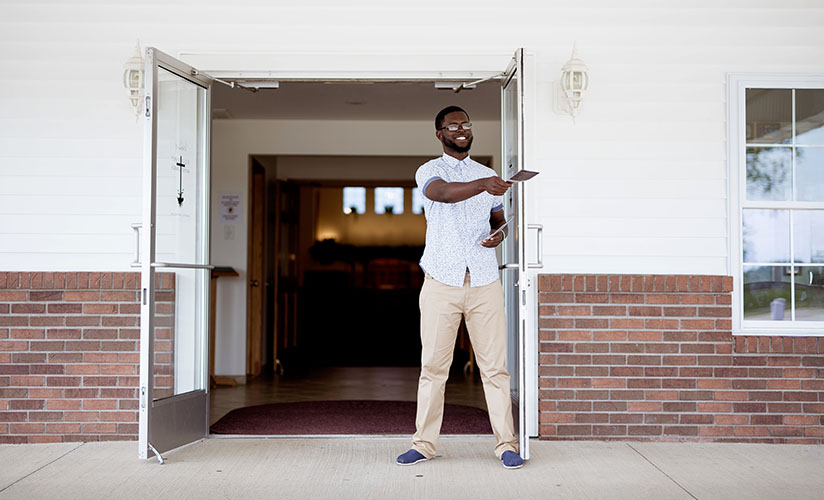
It’s Time for New Chairs! We’ll help you raise the money!
We believe your members deserve the most comfortable, well-made chairs to sit on in church—chairs that last for years, while being easy to set up and store. We also know that outfitting your congregation with high-quality chairs requires a significant investment. We can do it together. This flyer can help!
Bertolini Makes the Best Chairs in the Industry!
- All Bertolini Impressions Chairs are made in the USA
- Built using superior materials
- Multiple fabrics and frame finish options
- Optional accessories available (bookrack, cup holder, etc.)
- Designed to provide extreme comfort
- Easy to transport, stack, and store
- Guaranteed quality with 25-year frame warranty
